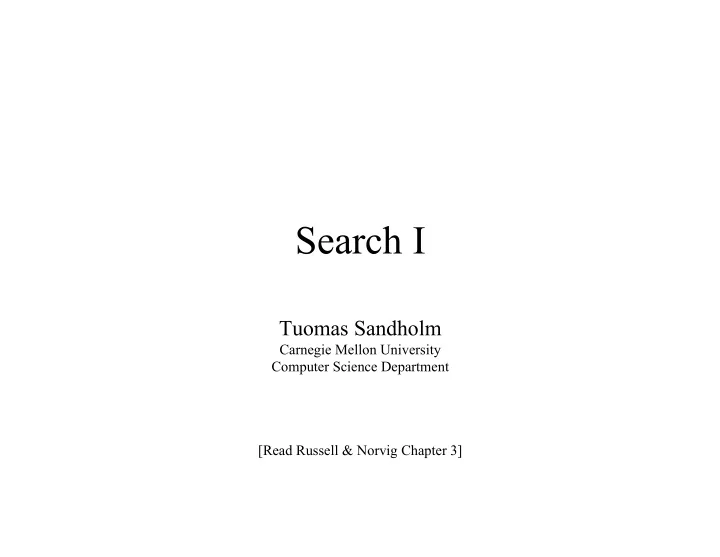

Search I Tuomas Sandholm Carnegie Mellon University Computer Science Department [Read Russell & Norvig Chapter 3]
Search I Goal-based agent (problem solving agent) Goal formulation (from preferences). Romania example, (Arad Bucharest) Problem formulation: deciding what actions & state to consider. E.g. not “move leg 2 degrees right.” No map vs. Map physical deliberative search search
Search I “Formulate, Search, Execute” (sometimes interleave search & execution) For now we assume full observability = known state known effects of actions Data type problem Initial state (perhaps an abstract characterization) ↔ partial observability (set) Operators Goal-test (maybe many goals) Path-cost-function Knowledge representation Mutilated chess board
Search I Example problems demonstrated in terms of the problem definition. I. 8-puzzle (general class is NP-complete) How to model operators? (moving tiles vs. blank) Path cost = 1
Search I II. 8-queens (general class has efficient solution) path cost = 0 Incremental formulation: Complete State formulation: (constructive search) (iterative improvement) States : any arrangement of 0 to 8 States : arrangement of 8 queens, 1 queens on board in each column Ops : add a queen to any square Ops : move any attacked queen to # sequences = 64 8 another square in the same column Improved incremental formulation: States : any arrangement of 0 to 8 queens on board with none attacked Ops : place a queen in the left-most empty column s.t. it is not attacked by any other queen # sequences = 2057 Almost a solution to the 8-queen problem:
Search I III. Rubik’ Cube ~ 10 19 states IV. Crypt arithmetic FORTY 29786 + TEN + 850 + TEN + 850 SIXTY 31486 V. Real world problems 1. Routing (robots, vehicles, salesman) 2. Scheduling & sequencing 3. Layout (VLSI, Advertisement, Mobile phone link stations) 4. Winner determination in combinatorial auctions …
Data type node • State • Parent-node • Operator • Depth • Path-cost Fringe = frontier = open (as queue)
Goodness of a search strategy • Completeness • Time complexity search cost • Space complexity • Optimality of the solution found (path cost = domain cost) • Total cost = domain cost + search cost
Uninformed vs. informed search Can only distinguish goal states from non-goal state
Breadth-First Search function BREADTH-FIRST-SEARCH ( problem ) returns a solution or failure return GENERAL-SEARCH ( problem , ENQUEUE-AT-END) Breadth-first search tree after 0,1,2 and 3 node expansions
Breadth-First Search … Max 1 + b + b 2 + … + b d nodes (d is the depth of the shallowest goal) - Complete - Exponential time & memory O(b d ) - Finds optimum if path-cost is a non-decreasing function of the depth of the node.
Uniform-Cost Search Insert nodes onto open list in ascending order of g(h). G inserted into open list although it is a goal state. Otherwise cheapest path to a goal may not be found. Finds optimum if the cost of a path never decreases as we go along the path. g(SUCCESSORS(n)) ≥ g(n) <= Operator costs ≥ 0 If this does not hold, nothing but an exhaustive search will find the optimal solution.
Depth-First Search function DEPTH-FIRST-SEARCH ( problem ) returns a solution or failure GENERAL-SEARCH ( problem , ENQUEUE-AT-FRONT) Alternatively can use a recursive implementation. • Time O(b m ) (m is the max depth in the space) • Space O(bm) ! • Not complete (m may be ∞ ) • E.g. grid search in one direction • Not optimal
Depth-Limited Search - Depth limit in the algorithm, or - Operators that incorporate a depth limit L = depth limit Complete if L ≥ d (d is the depth of the shallowest goal) Not optimal (even if one continues the search after the first solution has been found, because an optimal solution may not be within the depth limit L) O(b L ) time O(bL) space Diameter of a search space?
Iterative Deepening Search Breadth first search : 1 + b + b 2 + … + b d-1 + b d E.g. b=10, d=5: 1+10+100+1,000+10,000+100,000 = 111,111 Iterative deepening search : (d+1)*1 + (d)*b + (d-1)*b 2 + … + 2b d-1 + 1b d E.g. 6+50+400+3000+20,000+100,000 = 123,456 Complete, Optimal, O(b d ) time, O(bd) space Preferred when search space is large & depth of (optimal) solution is unknown
Iterative Deepening Search…
Iterative Deepening Search… If branching factor is large , most of the work is done at the deepest level of search, so iterative deepening does not cost much relatively speaking
Bi-Directional Search Time O(b d/2 )
Bi-Directional Search … Need to have operators that calculate predecessors. What if there are multiple goals? • If there is an explicit list of goal states, then we can apply a predecessor function to the state set just as we apply the successors function in multiple-state forward search. • If there is only a description of the goal set, it MAY be possible to figure out the possible descriptions of “sets of states that would generate the goal set”. Efficient way to check when searches meet: hash table - 1-2 step issue if only one side stored in the table Decide what kind of search (e.g. breadth-first) to use in each half. Optimal, complete, O(b d/2 ) time. O(b d/2 ) space (even with iterative deepening) because the nodes of at least one of the searches have to be stored to check matches
Time, Space, Optimal, Complete? b = branching factor d = depth of shallowest goal state m = depth of the search space l = depth limit of the algorithm
Avoiding repeated states More effective & more computational overhead With loops, the search tree may even become infinite
Recommend
More recommend